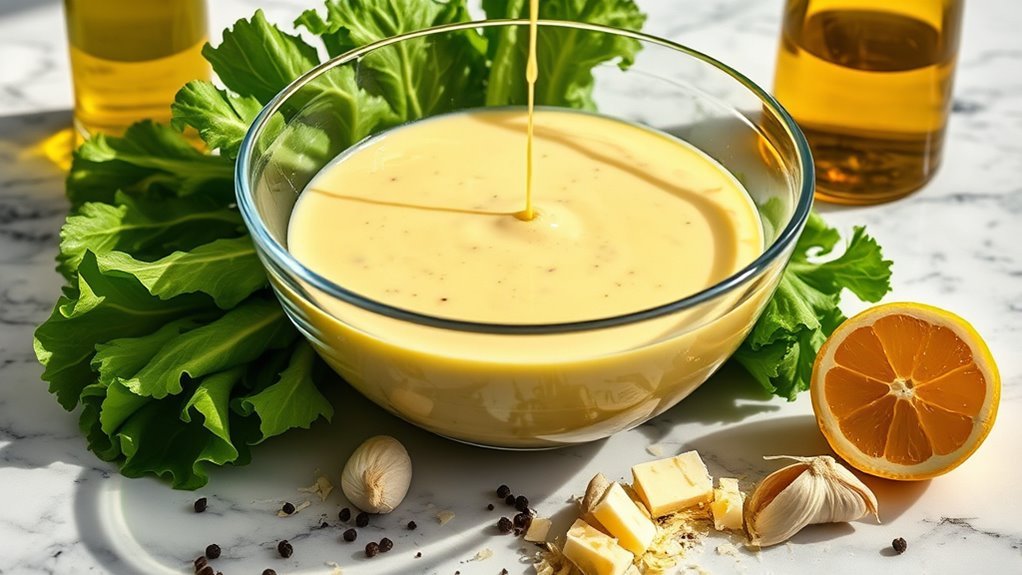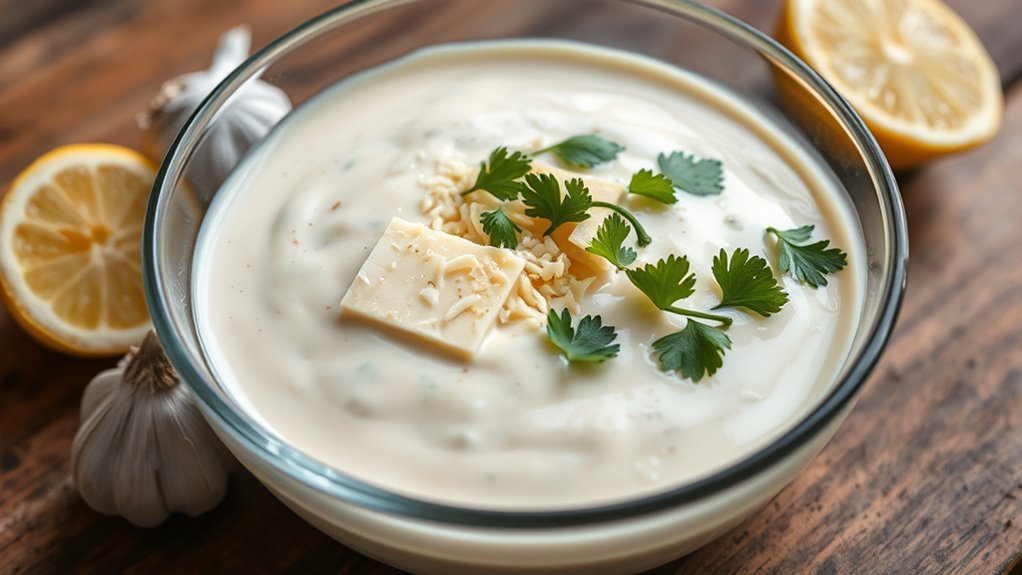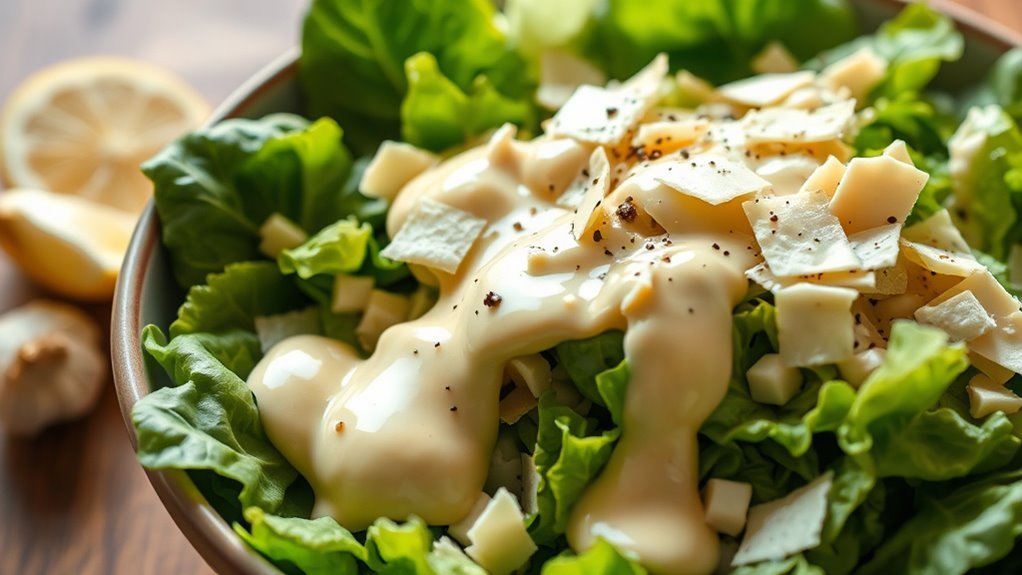Yes, Caesar dressing can fit into a keto diet if you choose low-carb ingredients and watch your portion sizes. Traditional dressings contain olive oil, anchovies, and Parmesan cheese, which are all low in carbs. However, store-bought versions may include added sugars, so it’s better to make your own. Use healthy fats like avocado oil or Greek yogurt, keeping everything keto-friendly. If you want tips on incorporating it into your meals, there’s more to explore.
Understanding the Keto Diet

When you consider adopting the keto diet, it’s vital to understand its core principles. At its heart, the keto diet emphasizes high-fat, moderate-protein, and very low-carbohydrate intake. This unique macronutrient ratio encourages your body to enter ketosis, a metabolic state where it burns fat for fuel instead of carbs. To navigate this diet successfully, effective meal planning is essential. Focus on incorporating healthy fats like avocados and nuts, alongside quality proteins from sources such as fish and poultry. Be mindful of hidden carbs in foods you might not expect. Tracking macronutrient intake is crucial for maintaining ketosis and ensuring you meet your dietary goals. By grasping these keto principles, you’ll gain the freedom to create satisfying meals that align with your health goals, making your keto journey enjoyable and sustainable.
Traditional Ingredients in Caesar Dressing

Caesar dressing is a classic staple known for its creamy texture and bold flavors. The traditional flavor profile includes ingredients like olive oil, garlic, anchovies, egg yolks, Parmesan cheese, and lemon juice. These components work together to create that rich, tangy taste you love. While this combination is beloved, there are common variations that swap or add ingredients to cater to different preferences. For instance, some recipes use yogurt or mayonnaise as a base instead of egg yolks, while others might incorporate different cheeses or even herbs. Understanding these traditional ingredients and variations can help you appreciate the versatility of Caesar dressing while staying true to its roots.
Carb Content Breakdown

When evaluating Caesar dressing for its keto-friendliness, it’s essential to look at the carb content of its ingredients. Typically, the primary components like oil and cheese are low in carbs, but additives can vary greatly. Additionally, serving sizes play an important role in determining whether a small amount fits within your daily carb limits.
Ingredient Carb Analysis
Understanding the carb content of each ingredient in Caesar dressing is essential for those following a keto diet. Traditional Caesar dressing primarily includes ingredients like olive oil, egg yolks, and Parmesan cheese, which are low in carbs. However, some variations might incorporate higher-carb sources like croutons or sugar-laden condiments, so it’s vital to check labels or recipes carefully. For instance, the addition of garlic or anchovies generally adds minimal carbs, while creamy variations may introduce heavier dairy products. If you’re making your own dressing, you can easily control the carb sources and stick to keto-friendly options. By being mindful of the ingredients, you can enjoy Caesar dressing while adhering to your dietary goals. Additionally, opting for homemade options allows for better control over carb limits and flavor.
Serving Size Impact
The serving size of Caesar dressing plays a significant role in its overall carb content. Understanding portion control can help you enjoy this dressing while staying within your keto goals.
| Serving Size (Tbsp) | Carbs (g) | Keto-Friendly? |
|---|---|---|
| 1 | 1 | Yes |
| 2 | 2 | Yes |
| 3 | 3 | No |
| 4 | 4 | No |
| 5 | 5 | No |
To maintain a low carb intake, it’s essential to be mindful of how much dressing you use. A smaller portion can keep your carb count low, allowing you to relish the creamy flavors without derailing your keto lifestyle. So, choose wisely!
Store-Bought vs. Homemade Caesar Dressing
When choosing between store-bought and homemade Caesar dressing, it’s essential to evaluate the ingredients. Store-bought versions often contain preservatives and added sugars, while homemade options allow you to control the quality and nutrition. By analyzing the nutritional differences, you can make a more informed decision that aligns with your dietary goals.
Ingredients in Store-Bought
While many people gravitate toward the convenience of store-bought Caesar dressing, it’s important to scrutinize the ingredient list. Store-bought options often contain preservatives, artificial flavors, and added sugars, which can compromise your keto goals. You might find ingredient variations like soybean oil or high fructose corn syrup that aren’t ideal for a low-carb lifestyle. Instead, look for brands that prioritize quality ingredients, such as olive oil, real cheese, and anchovies, while avoiding unnecessary fillers. Always check the nutrition label to verify it fits your dietary needs. By being mindful of what’s in your dressing, you can enjoy the flavor without sacrificing your health or keto-friendly choices. After all, knowledge is power when it comes to making informed decisions.
Benefits of Homemade Dressing
Opting for homemade Caesar dressing can greatly enhance your keto journey, as it allows you to control every ingredient that goes into the mix. By making your own dressing, you can avoid hidden sugars and unhealthy preservatives often found in store-bought options. This not only provides health benefits by keeping your ingredient list clean, but it also allows for flavor enhancement tailored to your personal taste. You can experiment with fresh garlic, quality olive oil, and aged cheese to create a dressing that suits your palate perfectly. Plus, preparing it at home can foster a sense of freedom in your cooking, empowering you to make healthier choices that align with your keto lifestyle while enjoying delicious flavors. Incorporating healthy fats into your dressing can further support ketosis and enhance the overall flavor profile.
Nutritional Comparison Analysis
Although store-bought Caesar dressings may seem convenient, a nutritional comparison reveals significant differences that can impact your keto diet. Homemade versions often provide better nutritional benefits, allowing you to control ingredients and avoid unnecessary additives. Here’s a quick comparison:
| Dressing Type | Carbs (per 2 tbsp) | Fats (per 2 tbsp) |
|---|---|---|
| Store-Bought | 3g | 10g |
| Homemade (Basic) | 1g | 8g |
| Homemade (Avocado) | 2g | 12g |
Incorporating dressings made from healthy fats can further enhance your keto-friendly meal options. You can customize dressing variations to suit your taste and dietary needs. By making your own Caesar dressing, you can enjoy a delicious, keto-friendly option that aligns with your health goals.
Keto-Friendly Alternatives
When it comes to finding keto-friendly alternatives to traditional Caesar dressing, there are plenty of options that can satisfy your cravings without derailing your diet. Consider using avocado oil or olive oil as a base; they’re rich in healthy fats and provide a delicious flavor. For a creamy texture, blend in some full-fat Greek yogurt or sour cream, making great keto swaps that keep your meals satisfying. You can also add Parmesan cheese and lemon juice for that signature tangy taste. Remember, it’s all about balancing flavors while sticking to your carb limits. With these alternatives, you can enjoy your Caesar salads and stay true to your keto lifestyle, indulging in the flavors you love. Additionally, incorporating healthy fats into your dressing can enhance satiety and support your low-carb journey.
Tips for Incorporating Caesar Dressing Into Your Diet
Incorporating Caesar dressing into your diet can be a flavorful way to enhance your meals, especially if you choose keto-friendly versions. You can easily drizzle it over a bed of fresh greens for a satisfying salad. Consider pairing it with grilled chicken or shrimp for added protein, making it a complete meal. If you’re looking for ways to pair it with vegetables, roasted broccoli or zucchini works wonderfully. To add some crunch, sprinkle on healthy toppings like sliced almonds or crispy bacon. Using a homemade version allows you to control the ingredients, ensuring it aligns with your dietary needs. Remember, moderation is key; a little dressing goes a long way in elevating your dishes without derailing your keto goals.
Final Thoughts on Caesar Dressing and Keto
While you might be concerned about finding dressings that fit your keto lifestyle, Caesar dressing can actually be a great option when chosen or prepared wisely. Many store-bought Caesar variations are low in carbs, but you should always check the labels for added sugars. If you’re looking for dressing substitutions, consider making your own with keto-friendly ingredients like olive oil, Parmesan, and lemon juice. This way, you control the ingredients and stay aligned with your goals. Incorporating Caesar dressing into keto recipes, such as grilled chicken salads or roasted vegetables, can enhance flavors and create satisfying meal pairings. Additionally, exploring low-carb alternatives can help you maintain your dietary goals. Ultimately, enjoy the freedom of experimenting with Caesar dressing while keeping your keto journey on track!
Frequently Asked Questions
Can I Use Caesar Dressing on a Salad With Keto-Friendly Vegetables?
Imagine a vibrant garden, lush with keto-friendly vegetables ready to be dressed in something delicious. You can absolutely use Caesar dressing on your salad, as long as you check the ingredients for hidden carbs. While traditional Caesar can be rich, there are also dressing alternatives that fit perfectly within keto guidelines. So, drizzle that dressing and enjoy your colorful, satisfying keto salad, embracing the freedom to indulge in flavors while sticking to your goals!
Is There a Vegan Version of Keto Caesar Dressing?
Yes, there are vegan versions of keto Caesar dressing! You can create one using vegan alternatives like cashew cream or silken tofu for creaminess. For flavor, try nutritional yeast, garlic, and lemon juice. Instead of traditional anchovies, use capers or seaweed for that umami kick. With these ingredient substitutions, you can enjoy a delicious dressing that fits both vegan and keto diets, allowing you the freedom to indulge in your salads guilt-free!
How Long Does Homemade Caesar Dressing Last in the Fridge?
Homemade Caesar dressing typically lasts about 3 to 5 days in the fridge. To maximize its shelf life, store it in an airtight container and keep it cold. It’s best to use fresh ingredients; the fresher they are, the longer your dressing will last. Always check for any off smells or changes in texture before using it. Following these storage tips helps guarantee you enjoy your dressing safely and deliciously!
Can I Use Caesar Dressing as a Marinade for Meats?
Yes, you can use Caesar dressing as a marinade for meats. The marinade benefits include enhancing flavor and promoting meat tenderness. The acidic components in the dressing, like lemon juice and vinegar, help break down proteins, resulting in juicier and more flavorful meat. Just be mindful of the dressing’s ingredients, as some may not align with your dietary preferences. Overall, it’s a delicious way to elevate your next meal!
Are There Any Dairy-Free Caesar Dressing Options Available?
Yes, there are dairy-free Caesar dressing options available! You can find brands that use dairy alternatives like cashew cream, almond milk, or nutritional yeast instead of traditional dairy ingredients. These alternatives maintain a creamy texture and rich flavor while catering to those avoiding dairy. When choosing a dressing, check the ingredient list to verify it aligns with your dietary preferences. Enjoy your salad without sacrificing taste or your dietary needs!


